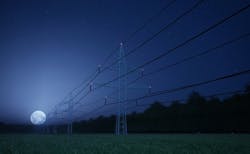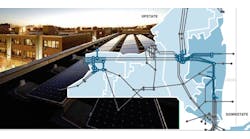One quote jumped at me in my light reading this morning across the grid publications spectrum.
“The rate of growth in electricity demand is entering a new era.”
Before any jokes about Captain Obvious and tell me something I don’t already know, let’s consider the unvarnished truth behind the words. Simple is good.
This brief statement of fact underpins a variety of the latest concerns over grid reliability brought up in a new report by the North American Electric Reliability Corp., the industry-led watchdog promoting reliability and standards within the U.S. and Canadian macro grid systems.
The report, “Collective Focus Imperative for Mitigating Emerging Risks to Grid Reliability,” is a broad NERC look-see at the various and myriad treats facing grid resiliency now and in coming years. Goals for merging sustainability and power reliability are driving movements into distributed energy resources and microgrids, the NERC report notes.
“Rapid growth of data centers, crypto mining and emerging green hydrogen…is resulting in many interconnection requests for large loads that, in addition to significant incremental demand, could also be sources of grid services and flexibility,” reads the NERC’s risk profile report. “Such large loads may also be paired with significant amounts of new generation, perhaps in a ‘behind the point of interconnection’ or ‘behind-the-meter’ configuration.”
The government-led drivers of new clean energy and electrification projects, such as the Inflation Reduction Act and the Infrastructure Investment and Jobs Act, are certainly going to further electrification load growth and challenges to meet that expansion from utility grid resources alone. While these incentivized energy aims sound good from an investment point of view, it’s equally true from a technology and reliability perspective that they require greater protection with services such as voltage control and reactive support, frequency response, ramping and balance and more assets to keep the macro grid stabilized.
Equipment must follow industry standards as it’s connected, whether that’s digitalization or inverter-based controls included in microgrid and other on-site power systems, the NERC report shows. Integration of renewables and battery storage are crucially intertwined with technologies which will balance and also allow for bidirectional flow of energy.
Microgrid Knowledge cares about all resources: Many Paths to NetZero
Microgrid 2024: The Revolution in Energy happening April in Baltimore
Our Call for Speakers now open and seeking session ideas
On-site power and microgrids connected through distribution system interconnection and following local requirements should also be in line with bulk power system (BPS) and national-type protocols.
“Distributed generation and storage (including behind-the-meter DERs and other DER technologies) currently follow local interconnection requirements and operational protocols that pose potential challenges to the BPS from a planning and forecasting perspective as penetration levels increase,” the NERC risk report reads. “New visibility, control and performance requirements may be needed to ensure BPS situational awareness and reliability.”
In fact, the entire historical concept of “resource adequacy” needs to be revamped given the “accelerated changes” in the resource mix (presumably with more intermittencies such as renewables and distributed starting points), extreme weather and fuel dependencies.
“NERC and the industry should collaborate to better understand and define energy sufficiency and develop approaches that examine the magnitude, duration and impact across all hours and many years while also considering limitations and contributions to reliability from all resources (including load resources), neighboring grids and transmission,” the risk report reads.
Click here to see the full NERC 2023 Reliability Risk Priorities Report.
More MGK Editor Takes
Microgrids at the Heart of Data Center Circulation
Energy Markets are Complicated, Unpredictable and Perfect for Microgrids








